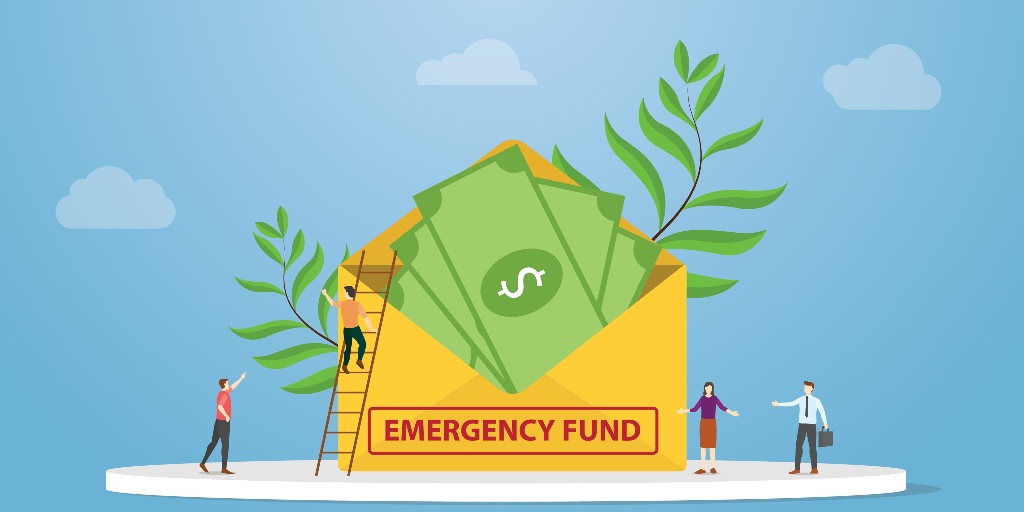Sinking Fund vs. Emergency Fund: How Do They Work?

- A sinking fund is for a specific saving goal.
- An emergency fund is for unexpected expenses.
- Together, these funds will slowly increase your financial health and stability.
Trying to save money can be super frustrating. It can seem like every time you save money, something comes up to drain your savings account…again. Whether that is something you need to purchase or a financial problem that can’t be avoided, it can be annoying to feel like you always hit a dead end with your money.
Fortunately, two saving techniques can help you become successful with your money. Those two savings techniques are a sinking fund and an emergency fund. These two funds could change your entire financial future!
What is a Sinking Fund?
A sinking fund is a fund formed by periodically setting aside money for a specific purpose, like paying off a large chunk of debt or saving for a new wardrobe.
Step-by-Step Guide to Creating a Sinking Fund
You’re convinced you want a sinking fund. How do you go about building one? Since a sinking fund requires a specific money goal, creating a sinking fund requires taking strategic steps.
1. Choose a Specific Saving Goal
A sinking fund is intended to buy something you want or pay for a large upcoming expense. That means you must choose something to save for to have a sinking fund. Let’s say you need a car or want to pay off a small debt. Pick the goal, and you are almost ready to start your sinking fund.
Recommended Read: Avoid Holiday Debt By Using a Sinking Fund
2. Determine How Much You Need to Save
Now that you know what you’re saving for, you need to determine your goal amount. Let’s stick with you wanting to buy a car, for example. Do you need the full price or a down payment? In this example, let’s say your car costs exactly $12,000. You want to buy it outright to avoid taking out a loan and having debt, so you need to save $12,000. Of course, you don’t want to forget taxes and fees when buying something expensive, but to keep it simple, we’ll ignore those for now.
3. Determine Savings Time Frame
A sinking fund is a practice of delayed gratification. You won’t have enough money right now to buy something very expensive. Naturally, you want to have your sinking fund goals paid for as soon as possible, but that shouldn’t come at the expense of living your day-to-day life, your health, or other important money goals like investing. That’s why you need to choose a realistic timeframe for your sinking fund.
If you want a car, but your current car is working well enough, you can probably wait a couple of years to get that new car you want. In that case, you will need to save $500 a month for two years to buy that $12,000 car. If you need a car sooner, say within the next year, you would need to save $1,000 a month. You simply take how many months you have to save and divide the total cost of the purchase by that many months.

Saving a large portion of your money for a long period may seem intimidating, but if you keep this rolling, you will become your own bank instead of using expensive financing, and you’ll have more money and a greater quality of life as a result. Remember, try not to put aside more than you can comfortably afford.
4. Start Automating Your Savings
Now that you know how much you need to put into your sinking fund it is time to start saving. Manually moving money from a checking account to a savings account every month for your sinking fund is inefficient and likely to be forgotten. Instead, set up automatic deposits. An automatic deposit can get your money into the right account to grow your sinking fund without your constant attention and makes it much more likely that your sinking fund will grow.
Recommended Read: Why People Use Automated Savings Plans
Where Do You Keep a Sinking Fund?
In general, sinking funds can be kept in a High Yield Savings Account to maximize interest while still being completely accessible, CDs (Certificates of Deposit) to get a slightly higher interest rate over a few months, or even short-term bonds depending on when you need the money.
Recommended Reading: Avoid Holiday Debt by Using a Sinking Fund
What is an Emergency Fund?
An emergency fund is for just that, emergencies. When you break a bone and need surgery, or you need a new roof due to heavy rain, these are financial emergencies. You didn’t know they were coming, but you wanted to be prepared for them, so you put money in an emergency fund. Traditionally, your emergency fund should have between 3 and 6 months of expenses saved in your emergency fund.

Recommended Reading: Five Signs of Financial Instability
Step-by-Step Guide to Creating an Emergency Fund
Since emergency funds are less specific than sinking funds, the steps are much simpler to start one.
1. Determine Your Emergency Fund Amount
There should be at least 3 to 6 months of expenses in your emergency fund. Some people say just start with $1,000 while you handle other financial issues like debt. Others say that you should have as much as one year of expenses set aside. However, if you live paycheck to paycheck, then saving a small amount, like $5 per paycheck, can make a difference in the long run.
2. Determine Your Savings Amount and Time Frame
Now that you know how much you want to set aside, it’s essential to look at your budget and determine how much you can put into your emergency fund each month or every time you get paid. Remember, it can be as little as $5. The key is to consistently put away money to increase your financial stability and prepare for the unexpected.
3. Save Money Automatically
Like a sinking fund, you don’t want to save manually. Automatic deposits can help you make savings a priority and will help you reach your financial goal faster. The less you have to think about it, the more likely it is to get done.

Where Do You Keep an Emergency Fund?
Since you never know when you will need an emergency fund, keeping your funds liquid is a good idea, meaning you can access them at any time. The best place for this, in general, is a High-Yield Savings Account. Ensure that your emergency fund account differs from your regular savings or sinking fund, so you don’t mix up the two funds.
The Difference Between a Sinking Fund and an Emergency Fund
Here is a breakdown of the difference between a sinking fund and an emergency fund.
Sinking Fund | Emergency Fund |
| Saving for a specific goal. | Saving for an unplanned expense (or emergency). |
| Very clear time frame for saving (and spending) your sinking fund. | Your emergency fund should always be full. |
| Mid-term saving goals mean you can use less liquid accounts (CDs or Bonds) | Must be liquid to handle immediate emergencies (cash or savings account). |
| You can have multiple sinking funds for different purchases. | You only need one emergency fund. |
The Money Wrap-Up
Sinking funds and emergency funds are different but vital parts of reaching your financial goals. Your first priority is to build a small emergency fund to save yourself from unplanned expenses that can lead to debt. Then, you can start saving in your sinking fund for large purchases to avoid debt and gain a greater quality of life.